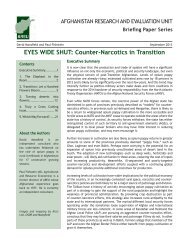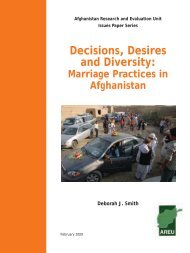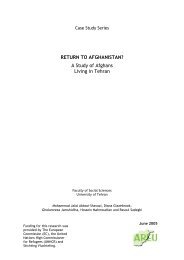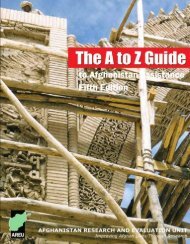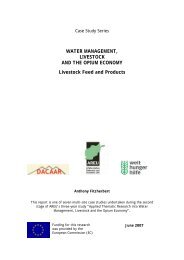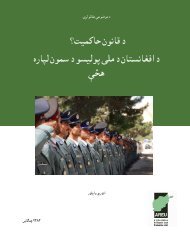Local Governance in Afghanistan: A View from the Ground
Local Governance in Afghanistan: A View from the Ground
Local Governance in Afghanistan: A View from the Ground
- No tags were found...
Create successful ePaper yourself
Turn your PDF publications into a flip-book with our unique Google optimized e-Paper software.
<strong>Afghanistan</strong> Research and Evaluation Unit<br />
2011<br />
2. The Research Project<br />
2.1 Research objectives and methodology<br />
Research objectives: The research has been designed, as <strong>the</strong> title <strong>in</strong>dicates, to exam<strong>in</strong>e what is<br />
happen<strong>in</strong>g on <strong>the</strong> ground <strong>in</strong> <strong>Afghanistan</strong>. Its primary objective is to better understand <strong>the</strong> progression<br />
of local government. In do<strong>in</strong>g so, it exam<strong>in</strong>es <strong>the</strong> nature of formal adm<strong>in</strong>istrative structures, along<br />
with <strong>the</strong>ir <strong>in</strong>teractions with <strong>in</strong>formal governance mechanisms at <strong>the</strong> local level. This analysis <strong>the</strong>n<br />
provides <strong>the</strong> basis for a discussion of policy. At a time when unprecedented levels of resources have<br />
been flow<strong>in</strong>g <strong>in</strong>to <strong>Afghanistan</strong>, <strong>the</strong> ultimate aim is to contribute <strong>in</strong>formation that will help improve<br />
<strong>the</strong> structure and performance of local governance.<br />
Conceptual framework: The IDLG Subnational <strong>Governance</strong> Policy 11 can be <strong>in</strong>terpreted as describ<strong>in</strong>g<br />
two dist<strong>in</strong>ct systems of governance. The first is one of state organisation and adm<strong>in</strong>istration structured<br />
around local government officials and l<strong>in</strong>e departments. The second relates to elected bodies at <strong>the</strong><br />
prov<strong>in</strong>cial, district and village levels, <strong>the</strong> powers and roles of which are yet to be formalised <strong>in</strong> law.<br />
At present <strong>the</strong>se features vary significantly across different prov<strong>in</strong>ces and are supplemented by <strong>the</strong><br />
<strong>in</strong>fluence of <strong>in</strong>formal powerholders and local elites. The Policy also demonstrates <strong>the</strong> government’s<br />
desire to ma<strong>in</strong>ta<strong>in</strong> a strong measure of central <strong>in</strong>fluence—firstly, by monopolis<strong>in</strong>g control over<br />
appo<strong>in</strong>tments and, secondly, by ensur<strong>in</strong>g that officials report directly to <strong>the</strong> central government<br />
<strong>in</strong> <strong>the</strong> form of l<strong>in</strong>e m<strong>in</strong>istries or <strong>the</strong> president’s office. This complex and sometimes <strong>in</strong>consistent<br />
document is thus caught between a pressure to improve efficiency by decentralis<strong>in</strong>g responsibilities<br />
on <strong>the</strong> one hand and fear of <strong>the</strong> loss of control this might br<strong>in</strong>g on <strong>the</strong> o<strong>the</strong>r.<br />
To <strong>in</strong>vestigate <strong>the</strong> <strong>in</strong>stitutional framework of local governance <strong>in</strong> <strong>Afghanistan</strong>, <strong>the</strong> research splits<br />
prov<strong>in</strong>cial and district <strong>in</strong>stitutions <strong>in</strong>to four major vertical l<strong>in</strong>es of control (see Figure I). Vertical I<br />
consists of <strong>the</strong> offices of <strong>the</strong> prov<strong>in</strong>cial governor and <strong>the</strong> district governor, both of which draw <strong>the</strong>ir<br />
authority <strong>from</strong> <strong>the</strong> office of <strong>the</strong> president. As heads of <strong>the</strong> prov<strong>in</strong>cial and district adm<strong>in</strong>istrations, all<br />
adm<strong>in</strong>istrative decisions taken at <strong>the</strong> prov<strong>in</strong>cial and district levels respectively should ideally have<br />
<strong>the</strong> sanction of <strong>the</strong> prov<strong>in</strong>cial and district governors. Vertical II consists of <strong>the</strong> prov<strong>in</strong>cial and district<br />
l<strong>in</strong>e departments or representatives of central m<strong>in</strong>istries. L<strong>in</strong>e departments have important service<br />
and justice delivery functions and, as shall be seen, tend to function as self-conta<strong>in</strong>ed units with little<br />
collaboration between <strong>the</strong>m. It is also worth not<strong>in</strong>g that not all central m<strong>in</strong>istries ma<strong>in</strong>ta<strong>in</strong> offices<br />
or personnel at <strong>the</strong> district level. 12 Vertical III is composed of representative <strong>in</strong>stitutions <strong>in</strong>clud<strong>in</strong>g<br />
prov<strong>in</strong>cial councils, District Development Assemblies under <strong>the</strong> National Area-Based Development<br />
Programme, District Community Councils under <strong>the</strong> <strong>Afghanistan</strong> Social Outreach Program (ASOP) and<br />
o<strong>the</strong>r district shuras, Clusters and Community Development Councils (CDCs) formed under <strong>the</strong> National<br />
Solidarity Programme (NSP). The f<strong>in</strong>al vertical consists of non-state actors, <strong>in</strong>formal powerholders<br />
and o<strong>the</strong>rs key actors <strong>in</strong> political and social mobilisation. These <strong>in</strong>clude Prov<strong>in</strong>cial Reconstruction<br />
Teams (PRTs), nongovernmental organisations, political parties, local commanders, members of ulema<br />
shuras (councils of clerics), maliks (community representatives) and arbabs (leaders/landlords). This<br />
vertical also <strong>in</strong>cludes newly emerg<strong>in</strong>g civil society organisations and broadcast<strong>in</strong>g <strong>in</strong>stitutions that<br />
exist ma<strong>in</strong>ly <strong>in</strong> prov<strong>in</strong>cial capitals.<br />
The aim of this <strong>in</strong>stitutional map is to present a generalised picture of local government at <strong>the</strong><br />
prov<strong>in</strong>cial, district and village levels. The four verticals are not necessarily mutually exclusive and<br />
stakeholders may overlap across two or more of <strong>the</strong>m. In each prov<strong>in</strong>ce, responsibilities for plann<strong>in</strong>g,<br />
budget<strong>in</strong>g and service and justice delivery may lie with one or more stakeholders represented along<br />
each row. The division of responsibility and flow of accountability between <strong>the</strong> <strong>in</strong>stitutions along<br />
each vertical are similarly variable, especially among formal government structures. Understand<strong>in</strong>g<br />
how <strong>the</strong>se different stakeholders <strong>in</strong>teract <strong>the</strong>refore forms a central feature of <strong>the</strong> study.<br />
11 “Executive Summary: Sub-national <strong>Governance</strong> Policy” (Kabul: Independent Directorate of <strong>Local</strong> Government, 2010).<br />
12 L<strong>in</strong>e departments commonly present <strong>in</strong> districts are: M<strong>in</strong>istry of Interior, Huqooq, Saranwali, Qazi, M<strong>in</strong>istry of Education,<br />
M<strong>in</strong>istry of Public Health, MRRD, MAIL and M<strong>in</strong>istry of F<strong>in</strong>ance.<br />
<strong>Local</strong> <strong>Governance</strong> <strong>in</strong> <strong>Afghanistan</strong>: A <strong>View</strong> <strong>from</strong> <strong>the</strong> <strong>Ground</strong><br />
10



